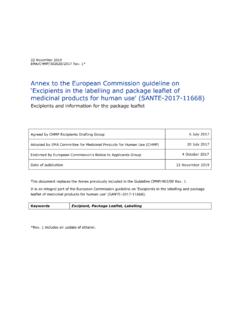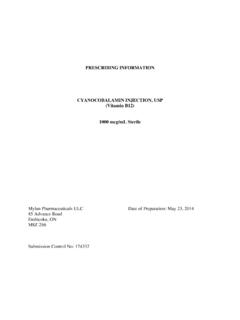Transcription of Information for the package leaflet regarding polysorbates ...
1 30 Churchill Place Canary Wharf London E14 5EU United Kingdom An agency of the European Union Telephone +44 (0)20 3660 6000 Facsimile +44 (0)20 3660 5555 Send a question via our website European Medicines Agency, 2018. Reproduction is authorised provided the source is acknowledged. 19 November 2018 1 EMA/CHMP/190743/2016 2 Committee for Medicinal Products for Human Use (CHMP) 3 Information for the package leaflet regarding 4 polysorbates used as excipients in medicinal products for 5 human use 6 Draft 7 Draft agreed by Excipients Drafting group 1 August 2018 Adopted by CHMP for release for consultation 20 September 2018 Start of public consultation 19 November 2018 End of consultation (deadline for comments) 31 May 2019 Agreed by Excipients Drafting group <Month YYYY> Adopted by CHMP <DD Month YYYY> Date of publication <DD Month YYYY> 8 9 Comments should be provided using this template.
2 The completed comments form should be sent to 10 Keywords Excipients, package leaflet , polysorbates 11 12 Information for the package leaflet regarding polysorbates used as excipients in medicinal products for human use EMA/CHMP/190743/2016 Page 2/42 Information for the package leaflet regarding 13 polysorbates used as excipients in medicinal products for 14 human use 15 Table of contents 16 Executive summary .. 3 17 Proposal for updated Information in the package leaflet .. 5 18 Scientific background .. 7 19 Introduction .. 7 20 1. 7 21 Category (function) .. 7 22 Physico-chemical Properties .. 7 23 Use in medicinal products .. 9 24 Regulatory status in 10 25 Regulatory status in cosmetics .. 10 26 2. Pharmaco-toxicological data .. 10 27 Pharmacodynamics and Safety Pharmacology .. 11 28 Toxicology.
3 16 29 Toxicokinetics .. 19 30 3. Pharmacokinetics (in humans) .. 20 31 ADME (absorption, distribution, metabolism, elimination) .. 20 32 PK in 21 33 Interactions .. 22 34 4. Clinical safety data .. 23 35 Safety in adults .. 23 36 Safety in children .. 26 37 5. Safety Information relevant for the package leaflet .. 28 38 References Bibliography .. 35 39 40 41 Information for the package leaflet regarding polysorbates used as excipients in medicinal products for human use EMA/CHMP/190743/2016 Page 3/42 Executive summary 42 This document has been written in the context of the revision of the Annex of the European 43 Commission Guideline on Excipients in the labelling and package leaflet of medicinal products for 44 human use (Annex, 2017; EC, 2018). polysorbates are currently not listed in the Annex to the 45 guideline on Excipients in the label and package leaflet of medicinal products for human use 46 Polysorbate 80 (PS 80, polyoxyethylene sorbitan monooleate, also known as Tween 80) and 20 (PS 20, 47 polyoxyethylene sorbitan monolaureate, also known as Tween 20) are mixtures of the partial esters of 48 sorbitol and its mono- and dianhydrides with oleic or lauric acid, resp.
4 , and condensed with 49 approximately 20 moles of ethylene oxide per mole of sorbitol and its anhydrides. They are used as 50 nonionic surfactants and as emulsifiers, being the most common surfactants used in biological 51 medicinal products for protein stabilisation. 52 Polysorbate was proposed to be added on the list of excipients for which safety issues ( potential 53 cardiotoxicity, phthalate extraction from polyvinyl chloride (PVC) materials, etc.) should be considered 54 for inclusion in the guideline. 55 Acute oral toxicity is low which is probably attributed to the very low oral bioavailability of intact 56 polysorbates . The acceptable daily intake (group ADI) for polysorbates as food additives ( polysorbates 57 20, 80, 40, 60 and 65; E 432, E 433, E 434, E 435 and E 436, respectively) was set to 25 mg/kg body 58 weight/day by EFSA in 2015 [23].
5 59 In view of the estimated maximum oral dose of PS 80 or PS 20 in authorised medicinal products of 60 about 1 mg/kg/day the oral exposure of PS 80 by oral formulations is estimated to be far below ADI. 61 Therefore, a warning on the effects of polysorbates as excipients by oral administration is not 62 considered meaningful. However, as it is known that polysorbate 80 increases gastrointestinal 63 absorption of other drugs, this potential PK interaction should be taken into account in SmPC/PIL (see 64 table for the package leaflet ). 65 In contrast to the oral route, after intravenous administration (IV) the whole amount of intact 66 polysorbates enter the bloodstream. The ability of polysorbates to enhance the uptake of drugs into 67 the brain constitutes a potential interaction with drug substances which should be taken into account 68 during benefit-risk evaluation of current and new parenteral products containing polysorbates .
6 As 69 hypersensitivity reactions including anaphylactoid shock have been observed after IV administration, a 70 warning of allergic reactions at threshold zero is proposed. 71 A significant hemodynamic effect (short duration vasoplegia, left ventricular systolic pressure 72 decreased) was observed in human adults after amiodarone IV bolus injection (Cordarone ) 73 containing 10 mg/kg PS 80 compared to a formulation without polysorbate and benzyl alcohol. In 74 dogs, bolus doses 10 mg/kg of PS 80 alone lead to depression of the cardiac conduction and 75 hypotension. Thus from the totality of preclinical and clinical data a threshold of 10 mg/kg (given as 76 bolus dose) is considered justified to trigger a warning regarding cardiovascular effects ( 77 hypotension). A small PK and safety study with anidulafungin infusions in infants and neonates with 78 maximum PS 80 exposure of mg/kg/day (max infusion rate over 60 min: mg/kg/min) gives 79 support that short term exposure of PS 80 < 10 mg/kg per day is safe even in infants and neonates.
7 80 The cardiovascular effects appeared to be rather related to the infusion rate than to the cumulative 81 dose. This might also explain the apparent safe use of MVI paediatrics (Multi-Vitamins for Infusion), a 82 US vitamin product for 24h infusion resulting in relatively high cumulative PS 80 exposure ( 83 mg/kg/day in 1 kg neonates), but at a quite low infusion rate of mg/kg/min. A small PK and 84 Information for the package leaflet regarding polysorbates used as excipients in medicinal products for human use EMA/CHMP/190743/2016 Page 4/42 safety study with anidulafungin infusions in infants and neonates with maximum PS 80 exposure of 85 mg/kg/day (max infusion rate over 60 min: mg/kg/min) gives support that short term exposure 86 at low infusion rates of PS 80 < 10 mg/kg per day is safe even in infants and neonates.
8 87 Thus, a general recommendation for risk minimisation by lowering the rate of injection/infusion is 88 given as a comment for consideration in the SmPC of parenteral products. 89 Risk for a cardiotoxic/torsadogenic potential of polysorbates is supported by in vitro data on hERG 90 current inhibition as well as from preclinical data showing an increase in effective refractory period 91 (ERP) in guinea-pig cardiac preparations and in vivo in dogs. There is no evidence so far for depression 92 of cardiac conduction from clinical data in humans which would allow derivation of a safety threshold 93 for cardiotoxicity. It is concluded that further (pre-clinical and) clinical electrophysiological studies are 94 warranted to investigate the torsadogenic potential of polysorbate 80 in detail. Currently at least a 95 warning on the risk of concomitant use of medications that prolong the QT/QTc interval should be 96 considered for the SmPC of all products containing polysorbates above this threshold of 10 mg/kg/day 97 when given as bolus.
9 98 The hepatotoxic potential of polysorbates gained notoriety after the E-ferol tragedy in the 1980s when 99 38 infant deaths were reported after IV infusion of this Vitamin E formulation containing a mixture of 100 polysorbate 80 (9%) and polysorbate 20 (1%) as solubilising agents. A clear dose-response 101 relationship was found with an increased risk for severe hepatotoxicity in premature infants at a PS 102 dose of > 80 mg/kg/d. Data suggested that the cumulative doses over 6-45 days rather than short 103 term peak exposure levels appeared to be relevant for hepatotoxicity. 104 However, case reports in adults at exposures below 80 mg/kg/d may indicate an earlier onset of signs 105 of hepatotoxicity: 35-40 mg/kg were calculated as the cumulative PS dose within 24 h identified in 106 case reports of hepatotoxicity in adults after Amiodarone IV, showing abrupt elevation of liver 107 enzymes.
10 Such case reports are confounded by the fact that amiodarone itself is a hepatotoxic agent, 108 however, the observation that subsequent oral amiodarone administrations in patients did not result in 109 additional liver toxicity supports the association with the intravenous exposure of the excipient. 110 In conclusion, a threshold of 35 mg/kg/d for all age groups is suggested to trigger a warning for 111 elevation of liver enzymes. 112 polysorbates exposure via administration of therapeutic proteins and vaccines is very low (< 113 mg/kg) being below all thresholds apart from zero. This is considered appropriate as it is in line with 114 the absence of any signal of cardiotoxicity or hepatatoxicity after vaccine exposure from epidemiology 115 or pharmacovigilance. 116 Information for the package leaflet regarding polysorbates used as excipients in medicinal products for human use EMA/CHMP/190743/2016 Page 5/42 Proposal for new Information in the package leaflet 117 Name Route of Administration Threshold Information for the package leaflet Comments polysorbates (E 432 436) oral Zero This medicine contains x mg of polysorbate* in each <dosage unit> <unit volume> <which is equivalent to x mg/<weight> <volume>>.












